Sadly, there are no tactical nukes awaiting you in a Colonial Marines spaceship above the planet PK-L7. But you’ll be battling hordes of aliens in this take on the classic Zombicide franchise.

What Is Zombicide: Invader?
Zombicide: Invader is a cooperative ‘dungeon crawl’-style game for 1-6 players, ages 14 and up. It has a variable playtime of 60-120 minutes, depending on which mission you play. It is published by CMON Games, and retails for $99.99. This standalone entry in the Zombicide series of games is not compatible with previous versions, and is available through their online store, or from many online retailers such as Miniature Market, Cool Stuff Inc, or Amazon.
In Zombicide: Invader, you will guide both soldier and civilian survivors at a planetary outpost through missions of varying length and difficulty as you try to scavenge for equipment, fulfill the mission’s objectives, and stay alive while the zombified aliens swarm the facility.

Zombicide: Invader Components
Here’s what you’ll find in the box:
- 72 detailed miniatures
- 9 double-sided game tiles
- 6 survivor dashboards and ID cards
- 6 survivor colored bases
- 6 dice
- 48 trackers
- 125 mini cards
- 65 tokens
- 1 rulebook
They say a picture is worth a thousand words. So here are a several thousand words worth of pictures showing you what you’ll find inside the Zombicide: Invader box:
CMON is known for their miniature-filled games, and this one is no exception. There are six survivors to choose from in the box, and 64 aliens, or “xenos,” to combat.

Of the 64 xenos, there are four types: Workers, Hunters, Tanks, and a Spoiler Abomination. The Workers are the weakest and most plentiful, with 35 figures. The fast Hunters and the sturdy Tanks clock in at 14 miniatures each, and there is just one of the large, powerful Spoiler Abominations. The xenos come in multiple poses, with the Workers having five different sculpts, and the Tanks and Hunters each having two sculpts.
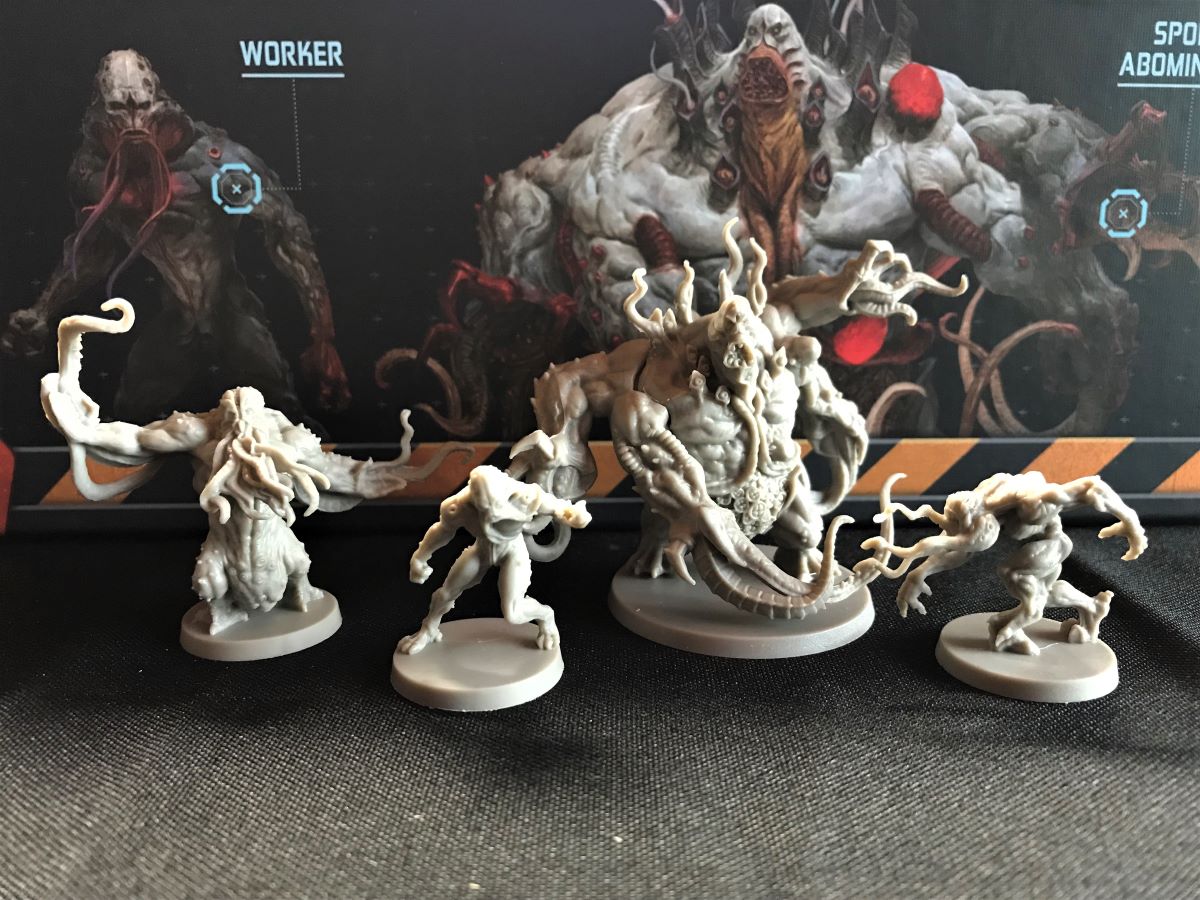
Rounding out the miniatures are a Peacekeeper Bot and a Falchion Sentry Gun, which are controllable by players in the game:
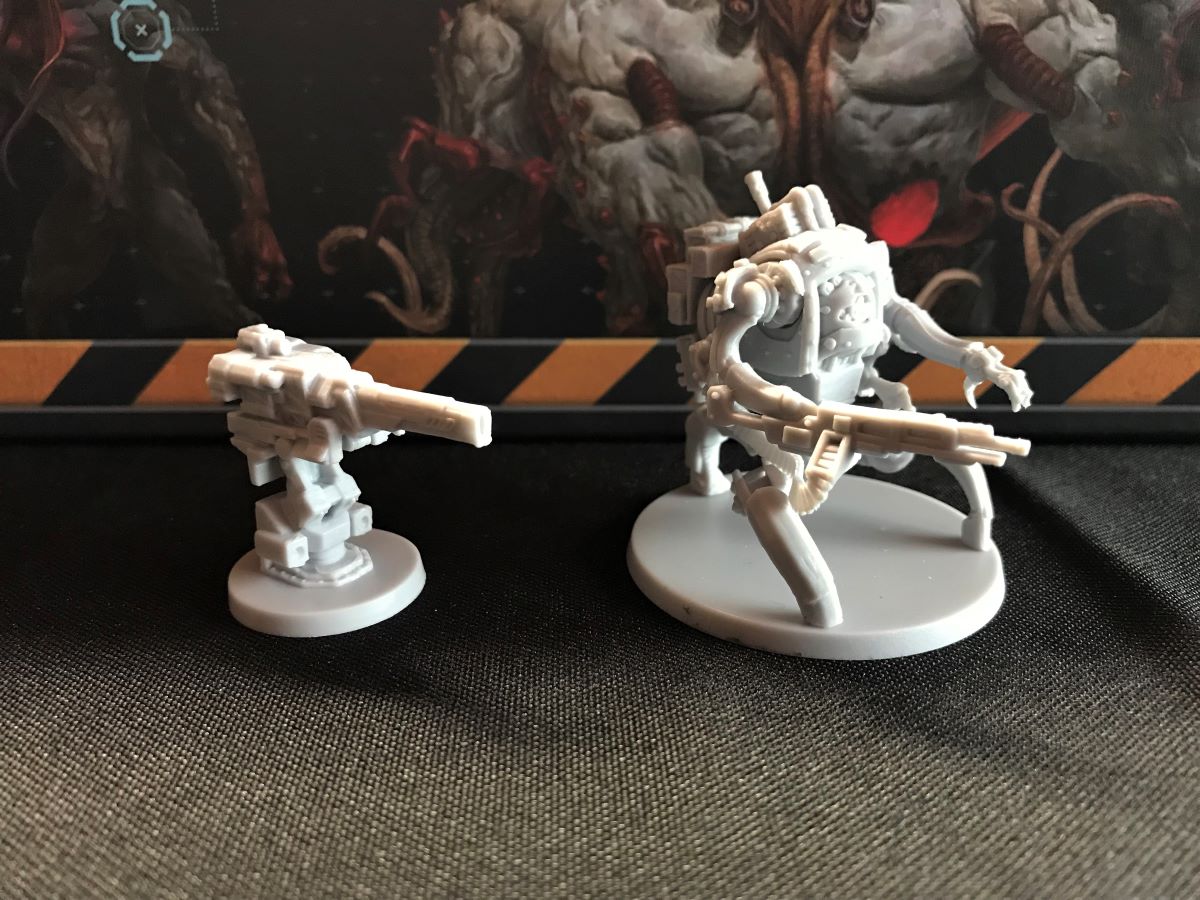
All of the miniatures are highly detailed and evocative of the science fiction theme. They come packed in molded plastic trays, and the inside of the components box has a helpful diagram on each side showing how the miniatures fit back into their trays:


The attention to detail continues with the plastic survivor dashboards. These dashboards hold your character and equipment cards and allow you to track experience points, armor points and skills. There are five plastic slots in the “backpack” that hold any items that aren’t currently equipped. And there are even horizontal slots for “attaching” equipment cards to weapons:
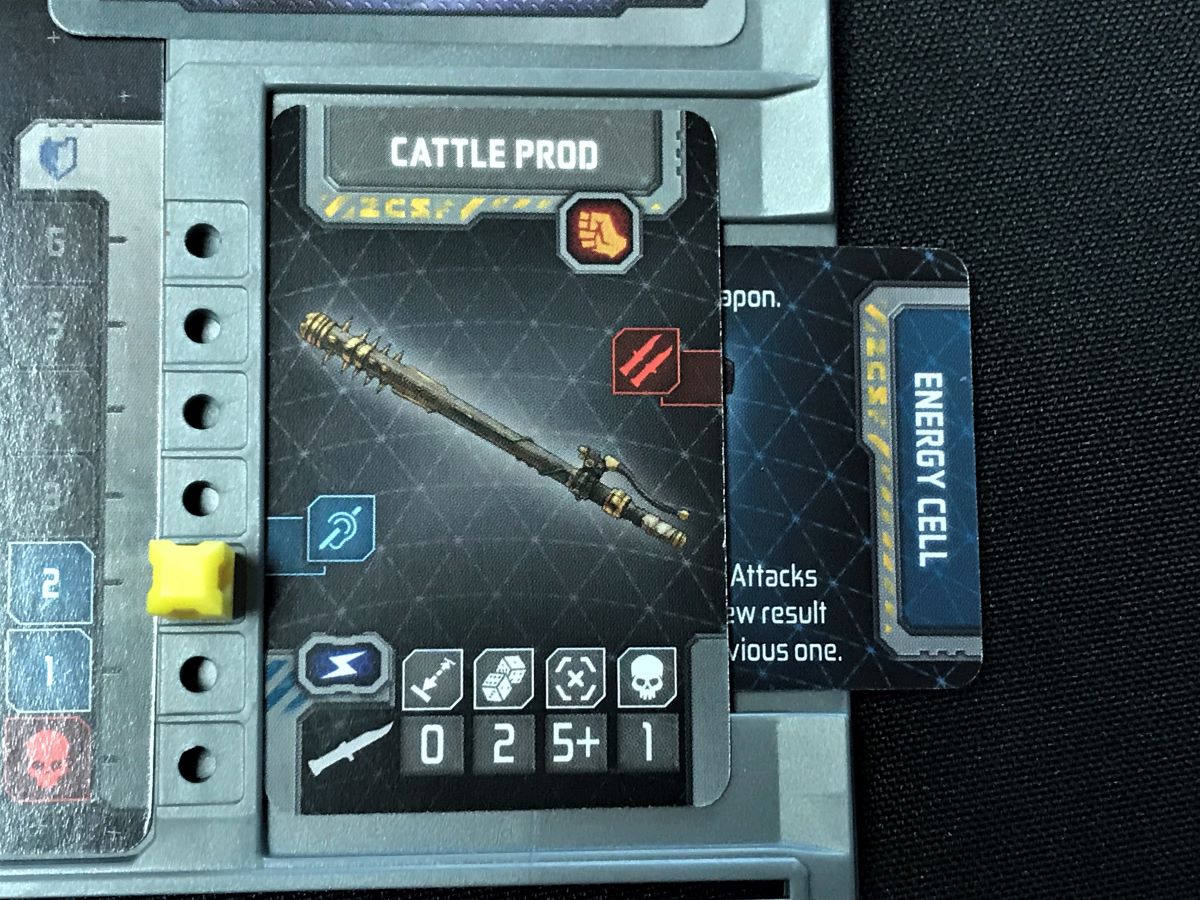
Zombicide: Invader comes with 9 double-sided thick cardboard map tiles. These tiles have a linen finish, and are filled with gorgeous, meticulous artwork depicting both the surface of the planet and the human outpost.

Most of the tokens are made from the same thick cardboard as the map tiles. The one exception is the “mold” tokens, which instead are made of thin card stock. While this is somewhat disappointing, it’s understandable as the size and quantity would add to the size and weight of the game box were they to be made of thick cardboard.

The rulebook is 55 pages, and clearly laid out. There are helpful illustrations of rules concepts throughout, and the 10 included missions are easy to understand and set up. There’s a guide to character skills and an index in the back, and a game round summary on the back of the rulebook. If only more rulebooks were so well produced!

Finally, the cards bear mentioning. As with previous editions of the Zombicide franchise, the many cards in the game are of a much smaller size than standard playing cards. Correspondingly, they are more difficult to shuffle. This has been a frustration since the very first Zombicide game, but again it’s likely a matter of necessity: using larger cards would require much larger dashboards, and as the game is already a table hog, would be very impractical. The one area where CMON can and should improve cards, however, is with their quality. While the cards themselves are reasonably sturdy, they easily lend themselves to “chipping.” This is where the artwork on the edges of the cards is chipped away from wear, showing the white of the cardstock underneath. You can see this in some of the photos throughout this review.

How to Play Zombicide: Invader

This is the sixth game in the Zombicide series. All the games share basic gameplay, so if you’ve played one the earlier versions before and you’re only only interested in the rules changes, you should scroll ahead to the ‘New Rules for Invader‘ section.
The Goal
Each mission in Zombicide: Invader will have different objectives for players to fulfill in order to win. The players work cooperatively in order to fulfill those objectives. But in every mission, there are always two ways to lose. If one of the survivors is ever killed, then it’s game over, man. And if two spawn points are ever connected by a chain of active mold, then the facility is overrun and you also lose.
Setup

The players choose a mission from the rulebook, and follow the setup instructions to place the map tiles and any tokens indicated by the mission. They each then choose a survivor to play, taking the corresponding miniature and a plastic base and tracker pegs in the color of their choice. The starting equipment cards (four cattle prods and two SMGs) are then distributed to the characters.

Set the oxygen tank cards, machine reference cards, and prototype weapon cards aside. Place the dice and a pile of noise tokens next to the game board. Shuffle and place the spawn and equipment decks facedown. Place the survivors in their starting zone. Give one player the first player marker and you’re ready to begin.
Gameplay
There are three phases to play: a Player phase, a Xenos phase, and an End phase. I’m just going to give a brief overview of each of these phases and focus on a couple of specific gameplay examples to give you a feel for the game. If you want to get into all the rules details, CMON has helpfully provided a downloadable rulebook on their website.
In the Player phase, each character can initially perform 3 actions. The choices for those actions are:
- Move. Move from one zone to another. Moving past xenos requires one extra move for each alien in the zone you’re leaving.
- Search. Can only be done once per turn. Draw the top item in the equipment deck. You can immediately equip an item and reorganize your dashboard and backpack without spending an additional action…but you may also draw an unlucky xenos spawn card.
- Door Activation. One time per turn for free, you can open or close a door that hasn’t been destroyed.
- Reorganize/Trade. You can exchange any number of equipment cards or remote tokens with one other survivor in the same zone as you. Both players get a free reorganization of their dashboard with a trade. You can also spend one action to reorganize your dashboard.
- Combat Action. Take a ranged or melee action depending on what weapon(s) you have equipped.
- Take or Activate an Objective.
- Make Noise. Place a noise token in your zone.
- Machine Actions. If you have a corresponding machine skill or Remote Control token, or are standing in the same zone as the sentry gun, you can do one of the machine’s actions listed on their card.
- Do Nothing. End your turn, losing any remaining actions. Play then passes to the player on your left.
The following are a couple of sample player turns, to get a feeling for the flow of the game. In our first example, Cole is in a room without any xenos in it, so he can search. His starting skill is “+1 free search action,” which means he doesn’t have to spend one of his actions to do so. As he has the searchlight equipped in a body slot on his dashboard, he can draw two equipment cards instead of one.
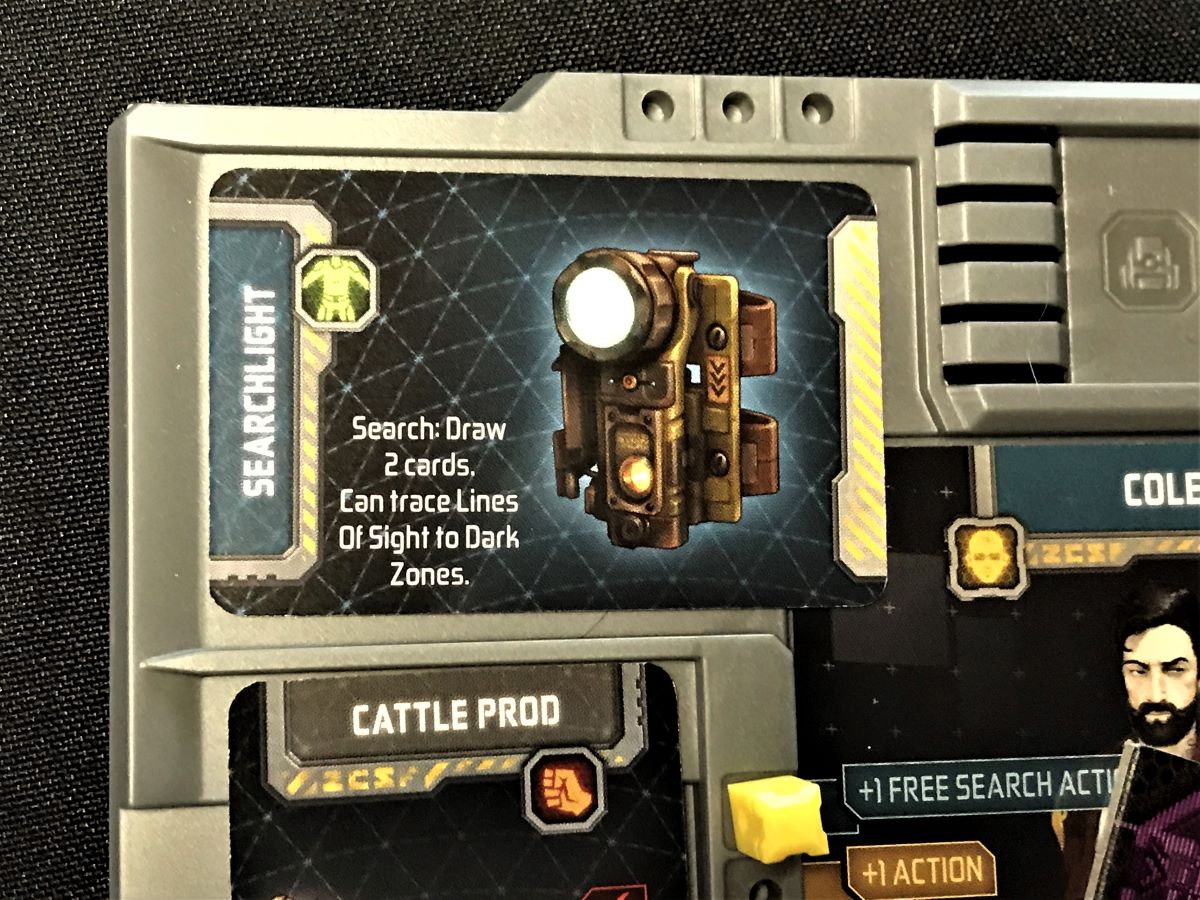
He draws the first card, and gets ablative armor, which he can equip and later discard to ignore a wound. That’s great! He’s not so lucky on his second card though, and draws a mold spawn card. He has to place one Tank miniature on each active mold token…now there’s a Tank just two zones away! Thankfully though, he still gets to draw another equipment card. Hopefully it won’t be another mold spawn…
It’s not. It’s actually something very useful right now, a chainsaw! Cole equips the chainsaw and the ablative armor, putting the searchlight into his backpack as he doesn’t want to risk more bad surprises.
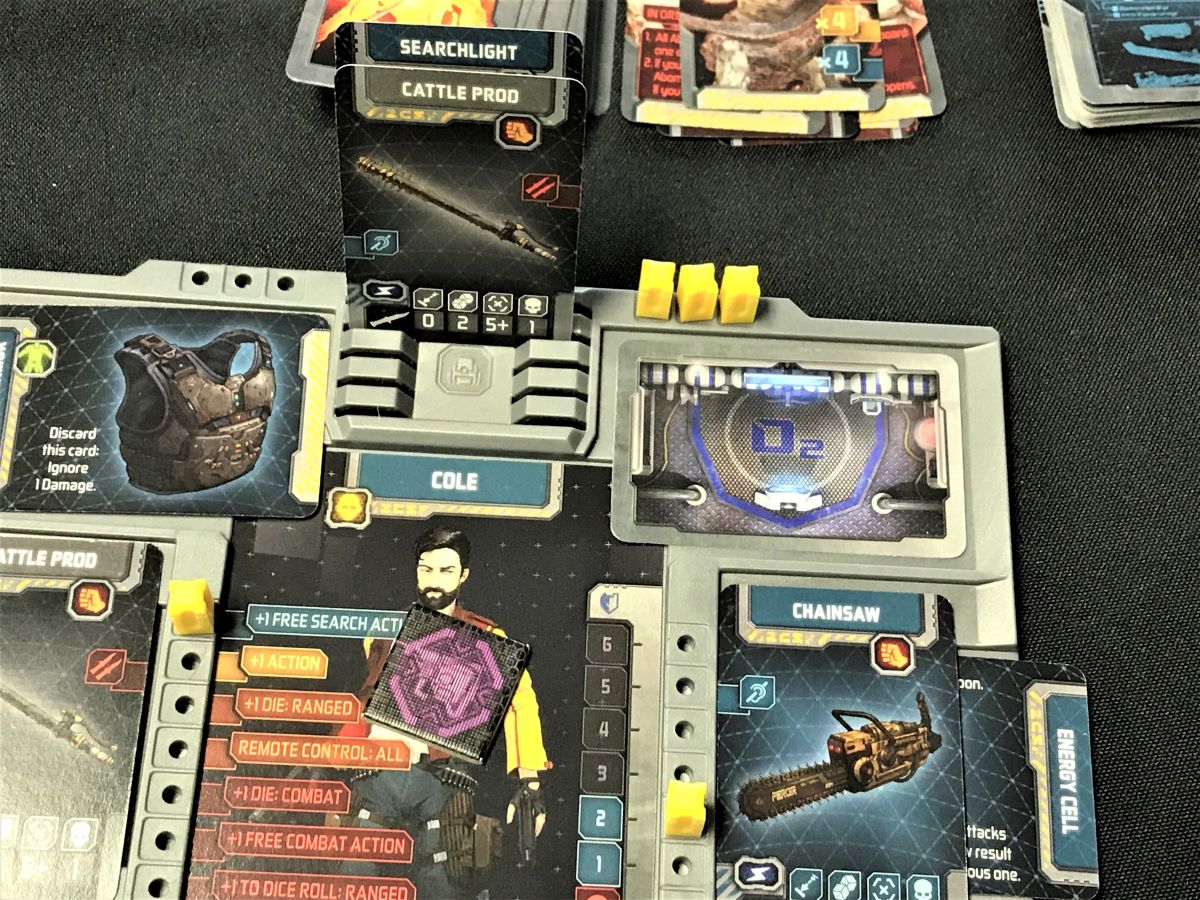
Spending his first two actions, Cole moves two spaces to enter the zone with the Tank. He then spends his final action to attack with the chainsaw. The chainsaw will do 2 damage for each successful (5+) hit of a roll of 5 dice, so Cole needs at least one success to take out the 2-wound Tank. He also has an energy cell equipped on the chainsaw, which will allow him to reroll all his dice once.

He doesn’t need the reroll though as one of the dice he rolls is a five, killing the Tank. Cole then gets one XP, leaving him one point shy of leveling to the yellow level. While he would get an additional action each turn once he’s in the yellow level, he also make the game harder for everyone as xenos spawns become progressively larger the higher the level you reach.

In another example, Vivian is wielding dual SMG’s, but weapons with bullet ammunition only work indoors. She can’t shoot, and she also can’t move as there are too many xenos in her zone (each xenos costs one additional movement action when trying to leave that space).

Caught between a rock and a hard place, Vivian sees that Magnus’ turn is next. Before ending her turn, she trades with Magnus, giving him an energy cell. Magnus (with the blue character ring) will now have a free reroll on each attack he makes with his sledge.

It’s now Magnus’ turn. Even with the rerolls provided by the energy cell, it still takes him two actions to kill all the Workers. But this has gotten him into the yellow level, so he now has four actions total each turn. Using his third action, he moves into the space with the Tank.
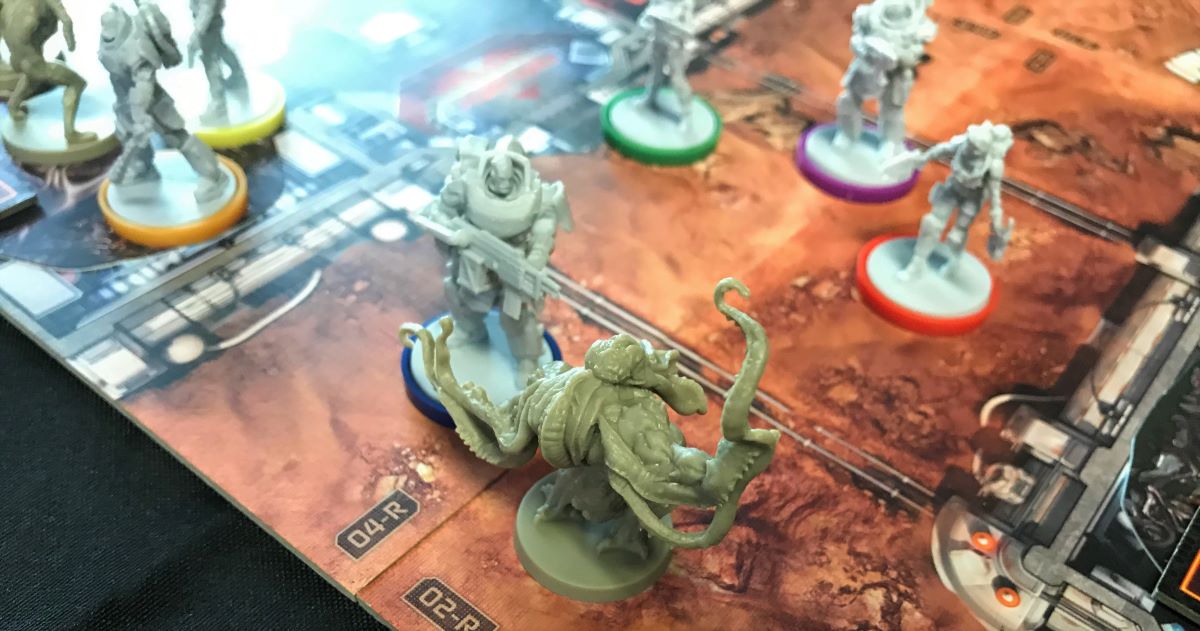
His weapon normally only does one damage on hits, which would not be enough to kill the 2-wound tank. However, for his final action he uses a concentrated attack to focus on the tank. He does two damage, taking out the tank as well and ending his turn. (I’ll explain more about concentrated attacks in the ‘New Rules‘ section a little later)
The Xenos phase is generally much quicker than the player phase, and broken into two steps. First, all the Xenos will either attack a survivor in their space or move towards the noisiest space. Survivors themselves make noise, as do bullet weapons, and noise tokens, which survivors can generate with the ‘make noise’ action.
In the second part of the phase, you draw a spawn card for each of the spawn points, placing the type and number of xenos indicated by the card and the highest danger level of all the survivors. Here are some sample spawn cards to show you some of the possibilities for what might pop up:
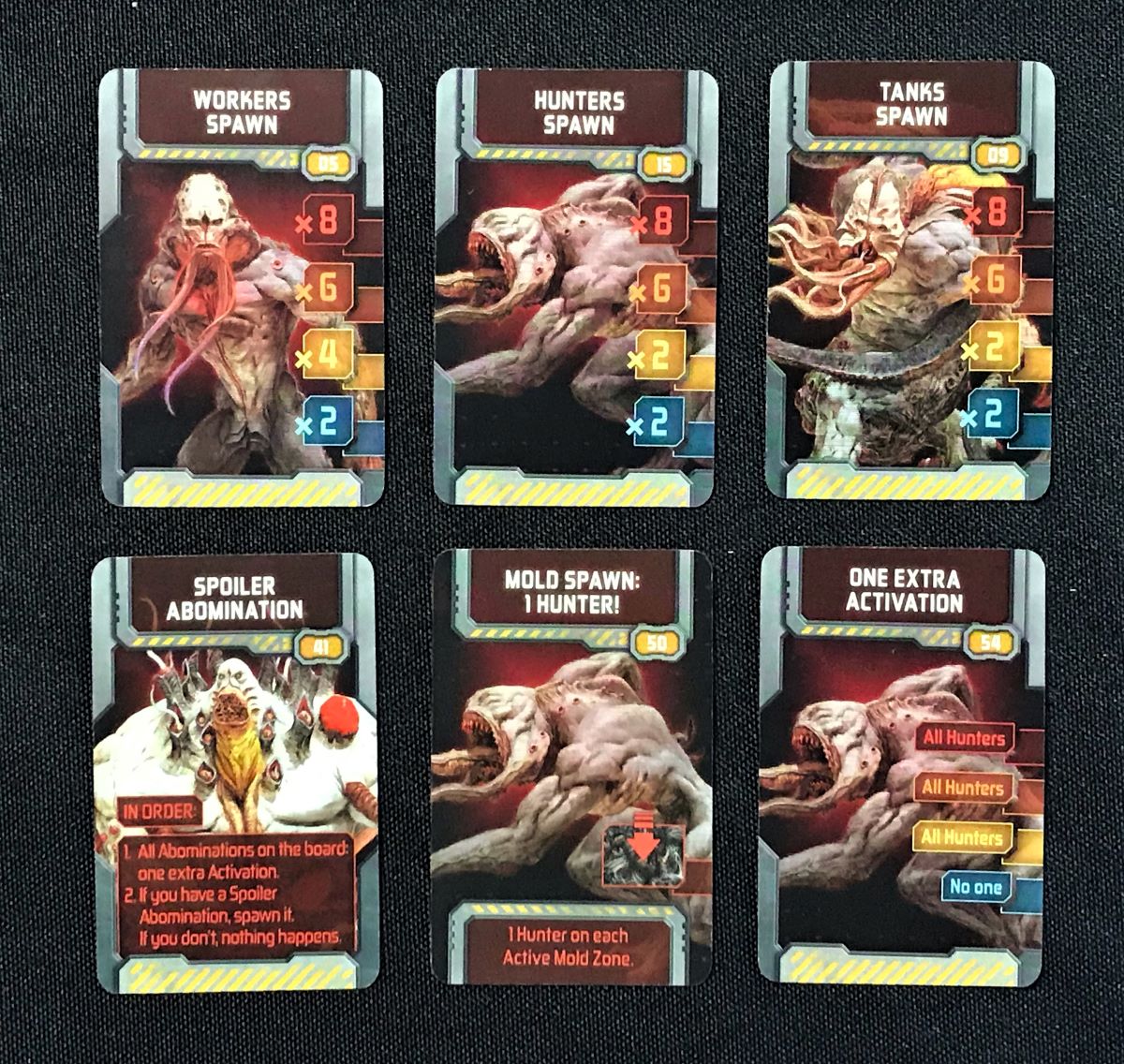
Finally, in the End phase, you remove any noise or machine activation tokens from the board, and the first player token gets passed clockwise.
Game End
Players continue the three phases until they have won by successfully completing the objectives listed on their mission briefing, or lost by either: A) one of the survivors dies or B) an unbroken chain of active mold is created linking two spawn points on the map.
New Rules for Invader
Each new version of Zombicide evolves the game, with new rules being introduced for the particular setting and returning rules being refined to improve gameplay. Here are the major changes for Zombicide: Invader:
- Mold. This is the major new mechanic for the game, and introduces a new challenge. Spoiler Abominations create mold, which essentially destroys a room. When mold is created, you remove any unclaimed tokens or abilities from the room, and you can no longer search for equipment there. If the token was something you needed to fulfill an objective for the mission, then the game ends. And if there’s ever an unbroken chain of active mold connecting two spawn points, you lose the game. Mold can never be destroyed, but it can be made inactive using hellfire, which requires both a flamethrower and a canister. Thankfully, Spoiler Abominations can’t create mold on the planet’s surface, only inside the outpost.
- Oxygen Tanks. Planet PK-L7 doesn’t have a breathable atmosphere, so your survivor must be equipped with an oxygen tank to go onto the planet’s surface. Some missions will start with the survivors outside and already equipped with one. But others will require you to find the blue-tinted ‘oxygen rooms’ on the map to get the oxygen tanks.

- Airlock Doors. The airlocks can never be destroyed, and are the only way for survivors or xenos to move between the outpost and the planet’s surface.
- Soldiers and Civilians. There are now two basic types of survivors. Civilians have lower armor (the equivalent of wounds) but can search in any room, whereas Soldiers can only search in the red Security Rooms, but have higher armor.
- Concentrated Attack. This is the biggest change from previous versions of Zombicide, and a welcome one. When you normally make a shooting attack, you choose a zone to shoot into, and then apply your successful hits in a target priority listed in the rulebook. In previous game versions, to kill a Tank you would need a weapon that did at least two damage per successful hit, and to kill an Abomination would take a rare three-damage weapon. But with a concentrated attack, you focus all your attack rolls on one model, and each hit gets added to the others, so if you’re very lucky you could even kill an abomination with a weak one-damage weapon. This gives players a lot more options for dealing with the xenos on their turn.
The Kickstarter Conundrum
As with most of CMON’s big miniatures-filled games, Zombicide: Invader first launched on Kickstarter. The campaign successfully funded on May 3, 2018, and made over $3.3 million dollars. I backed at the “Civilian” level, which gave me the core game box, an exclusive Allyson Cardenal survivor, and all the stretch goals for that pledge level.
Even though they launch on Kickstarter, these big CMON games always end up available to purchase at retail. So the question that most gamers have to ask themselves is, “should I back the Kickstarter campaign, or wait to buy it at retail?” If you back at retail, you can often pay a discounted price for the game, as well as possibly avoid the ever-rising shipping costs for these physically heavy games. However, there’s no guarantee that Kickstarter backers will receive their games first. As a backer in California, to my frustration I saw Zombicide: Invader available to purchase at stores a few weeks before my own copy finally arrived at my door.
So why back a CMON Kickstarter campaign? If you’ve ever backed one before, you know the biggest reason: for the extras. The Zombicide: Invader campaign was jam-packed with various stretch goal rewards, many of them exclusive to the campaign itself. Here are the ones that I received, backing at just the most basic level:
There were even more stretch goal rewards available backing at a higher level, as well as many optional buys, some of which may not make it to retail. Though let me be clear: the game is perfectly enjoyable to play without any of the Kickstarter extras. I personally chose to back this game on Kickstarter because I enjoy the additional options the Kickstarter extras afford me for gameplay variety.
The reason I bring up the conundrum is because Zombicide: Invader is hardly the last we’ll see of this franchise. CMON has announced an upcoming Kickstarter campaign for a 2nd edition of the very first Zombicide game, as well as for an app-driven technological/board game hybrid system named Teburu that will launch next year with Zombicide Evolution – Las Vegas. So you will have to weigh for yourself the benefits and drawbacks of Kickstarter vs. retail when those campaigns go live.
Expanding the Game
While the core Zombicide: Invader game provides a fantastic experience straight out of the box, there are many ways you can enhance and extend your gameplay past the 10 missions in the rulebook. A Zombicide game is not just a standalone experience, but a moddable gaming system. There are rules included for an ‘Ultrared Mode’ that allows you to keep leveling your survivors past the red skill level, as well as how to expand the game to 7+ players. And as mentioned above, if you backed the Kickstarter, the included stretch goals immediately add in more options for your games.
But if you didn’t back the Kickstarter, there are still several other options available to you. The Zombicide: Black Ops expansion, available in stores soon, adds six new survivors, ten new missions, new map tiles, equipment cards, machines, and a new Abomination, the Juggernaut.
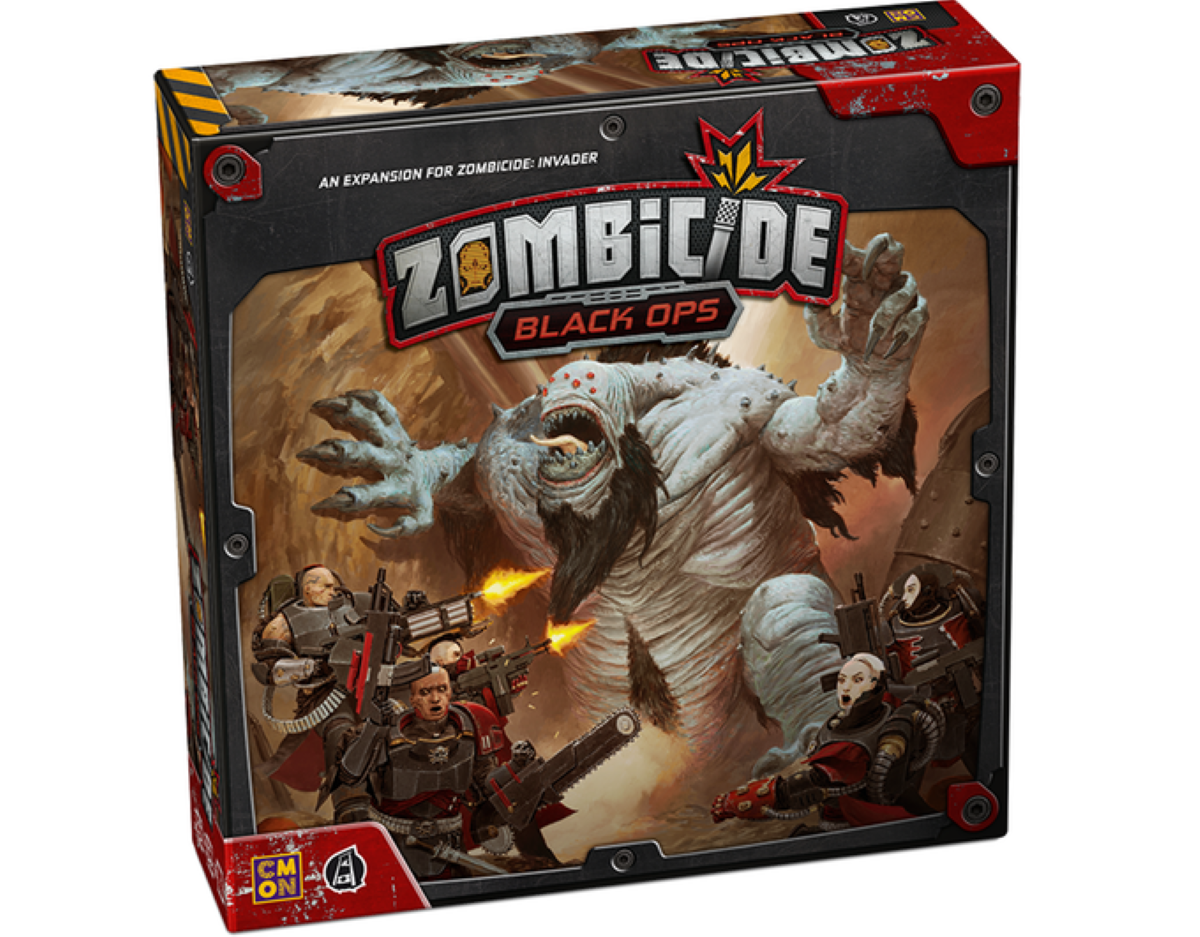
CMON also provides a free online map editor tool, which allows you to design your own missions for the game and post them on their website, or download other players’ missions.
Some people also like to ‘bling out’ their games. The detailed miniatures in Zombicide: Invader are just begging to be painted up, which I’m hoping to do after this review. And using two sets of Battle Systems Sci-Fi terrain, I recreated the first mission, “Gathering Forces,” in 3D. You can read my earlier review of that terrain here.
The Verdict: Zombicide: Invader
As I mentioned earlier, Zombicide: Invader is the sixth game in the Zombicide franchise. I’ve backed and played all of them on Kickstarter except for the fifth one, Zombicide: Green Horde. Obviously, I’m a fan of Zombicide. But what did I think of this particular entry in the series?
In short: I love it. I think it’s the best version of Zombicide to date.
Zombicide: Invader is GeekDad Approved!
At its heart, the fundamental game hasn’t changed since the very first version launched back in 2012. You play cooperatively alongside your friends as survivors fighting against hordes of the undead to accomplish the goals of a mission. You’ll search for equipment to fight your enemies, gain new skills as you level up, and face ever increasing odds against your making it out alive.
With Zombicide: Invader, CMON didn’t simply slap a science fiction theme on an earlier version of the franchise and call it a day. Little details, like the need for equipping oxygen tanks to go outside onto the planet’s surface because of the unbreathable atmosphere, and consequently not being able to use the flamethrower outside for the same reason, bring highly thematic wrinkles to the relatively simple gameplay.
The controllable machines are a great nod to sci-fi tropes, providing additional tactical choices to your gameplay. The Sentry gun immediately brings to mind a certain deleted scene from the movie Aliens. And who doesn’t like to command a hulking robot like the Peacekeeper Bot? Both machines are useful to mow down more of the xenos, or can even act as sacrificial lambs, distracting the xenos while you make your escape.

The new rule for concentrated attacks is quite literally a gamechanger. In previous versions of Zombicide, an early appearance by an Abomination would mean either likely death due to its powerful attacks, or several turns spent ‘kiting’ the Abomination while you desperately searched for the two components you needed to make hellfire in order to kill it. By using a concentrated attack, players now at least have a fighting chance at defeating it with many of the other weapons in the game.
While concentrated attacks may seem at first like they make the game easier, the Spoiler Abomination’s ability to both produce mold and turn inactive mold into active mold again balances this out. You may not be as inherently frightened of this particular Abomination, but the mold it leaves behind could end up costing you the game. Not to mention the ‘mold spawn’ cards, which add xenos to each active mold token…potentially resulting in a lot more angry xenos after your blood.
Even though Zombicide: Invader suggest ages 14+, unless you’re trying to keep your kids away from games involving guns, there’s no reason why you couldn’t play with children as young as 8 or so. The basic rules are very easy to follow, and as a cooperative game, younger kids could be coached on strategy and helped out with any of the more complex rules.
There are a couple of downsides. Being miniatures-heavy, setup can take a little more time than most games. And speaking of time, most of the missions will inevitably last longer than what’s listed in the rulebook, especially if your gaming group likes to discuss and plan out their turns. But for most, these issues are hardly dealbreakers.
If you’re looking for pure strategy, then this is not your game. Zombicide: Invader is more focused on creating an exciting cinematic experience. I always used to liken the original Zombicide to playing a board game version of the Robert Rodriguez film Planet Terror from the Grindhouse double feature. Like that movie, the game is filled with crazy, over-the-top action, and wild escapes from seemingly hopeless situations. If you enjoy a science fiction setting, and want a game that will give you memorable moments that you’ll recount with your friends and family for years afterwards, then go out and pick up a copy of Zombicide: Invader today.
![]() To subscribe to GeekDad’s tabletop gaming coverage, please copy this link and add it to your RSS reader.
To subscribe to GeekDad’s tabletop gaming coverage, please copy this link and add it to your RSS reader.



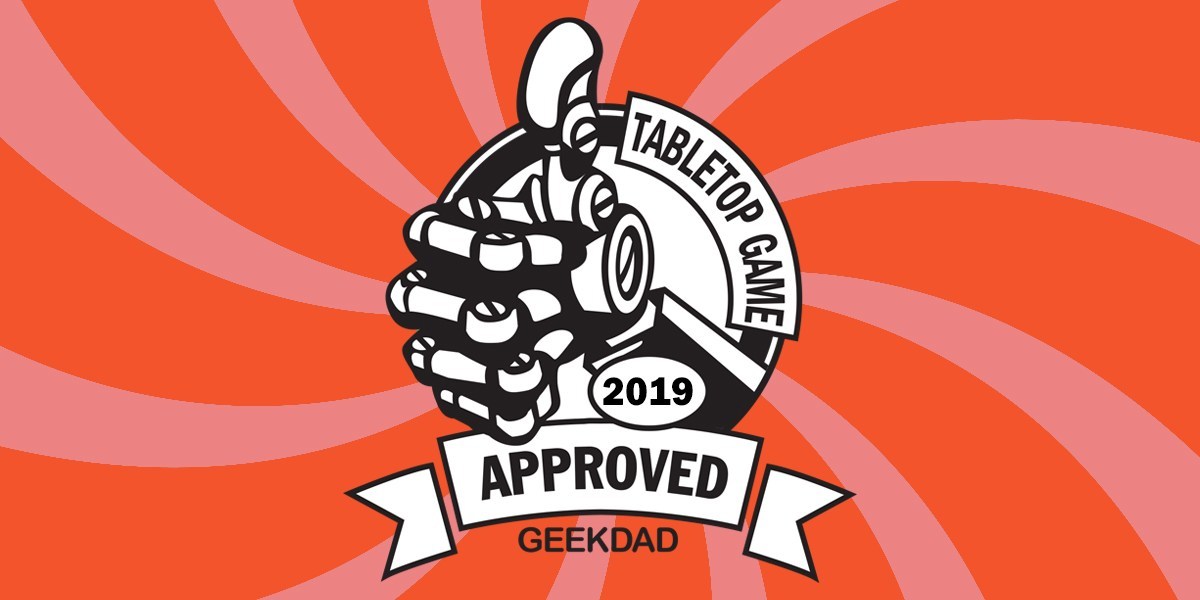




I really don’t like Kickstarter exclusives. With so many games being Kickstarted, I’m unable to back all the ones I’m interested in. But I’m often turned off by a game where content isn’t available for purchase when I didn’t fork over a bunch of money over a year in a half before the game’s release.
It think it is nice to have extras for backers, but locking them away makes it likely I will never make a purchase. I like what Stonemaier Games did with Scythe. Include extras in the pledge for backers, but make the extras available for purchase afterwords.
Kickstarter exclusives are always controversial. But they’re the carrot on the stick for backing a campaign, as opposed to waiting on retail. To make them readily available in retail after the campaign defeats the purpose of them.
If you ever go to gaming conventions, CMON(as well as some other companies) do sell some of their Kickstarter exclusives there.